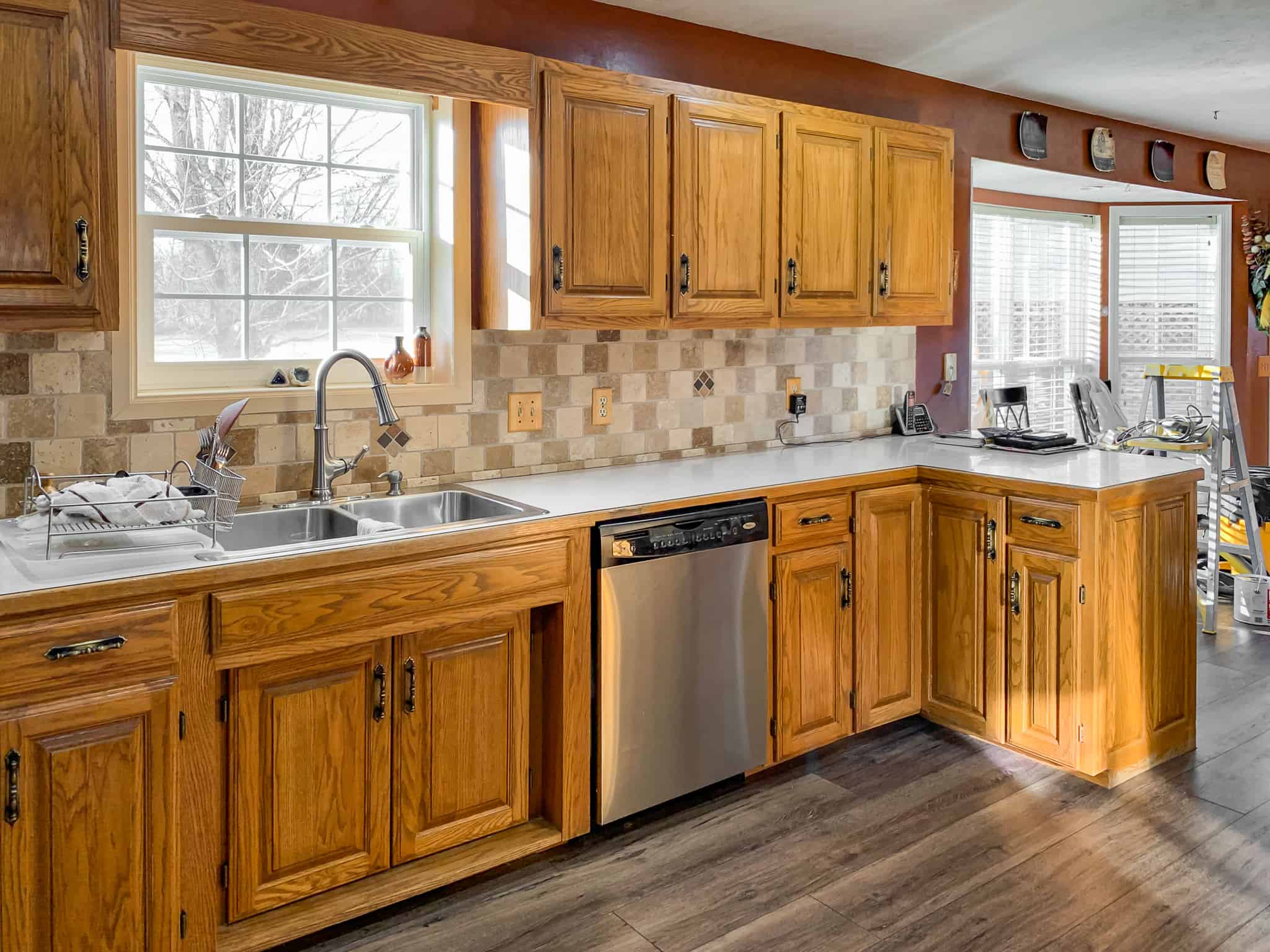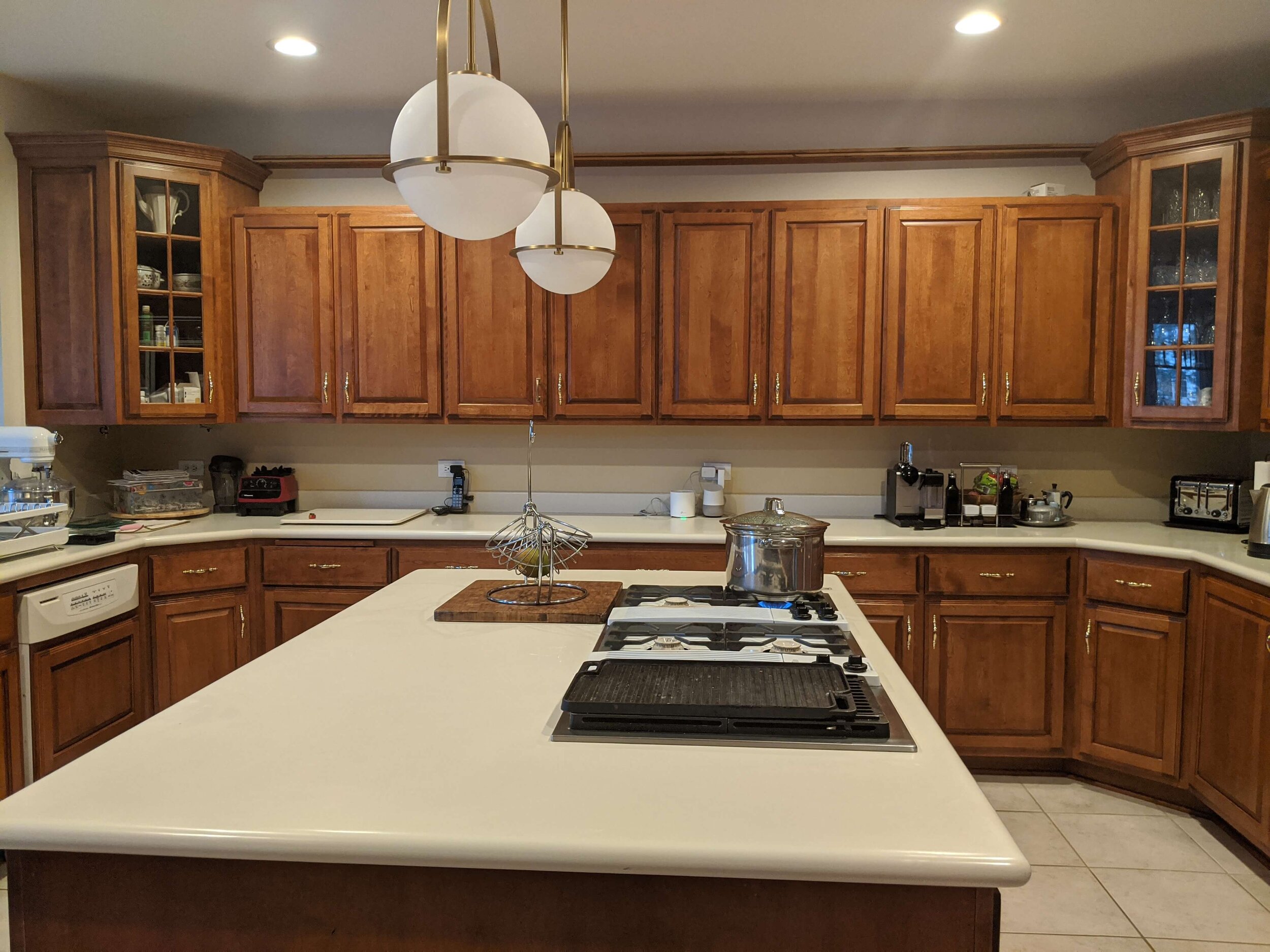Understanding Whitewashed Oak Kitchen Cabinets: Refinish White Washed Oak Kitchen Cabinets

Whitewashing oak kitchen cabinets is a popular trend that offers a fresh and modern look while preserving the natural beauty of the wood. This technique involves applying a thin layer of white paint or stain to the wood, creating a semi-transparent finish that allows the grain to show through.
Aesthetic Appeal
Whitewashed oak cabinets bring a light and airy feel to the kitchen, making the space appear larger and more inviting. The subtle white hue creates a clean and sophisticated backdrop for various kitchen styles, from farmhouse to contemporary. The natural wood grain adds warmth and character, preventing the whitewash from feeling sterile or overly stark. This combination of light and texture creates a timeless and elegant look that complements a variety of kitchen designs.
Pros and Cons of Whitewashing Oak Cabinets
Whitewashing oak cabinets offers a range of advantages and disadvantages that should be considered before undertaking the project.
Pros
- Adds a Modern Touch: Whitewashing can instantly update the look of traditional oak cabinets, giving them a more contemporary feel.
- Enhances Natural Grain: The semi-transparent finish highlights the unique grain patterns of the oak, adding depth and character to the cabinets.
- Creates a Light and Airy Atmosphere: The whitewash brightens the kitchen, making it feel more spacious and welcoming.
- Versatile Design: Whitewashed cabinets complement various kitchen styles, from farmhouse to contemporary.
Cons
- Requires Maintenance: Whitewashed cabinets may require more frequent cleaning and touch-ups to maintain their pristine appearance.
- Can Highlight Imperfections: The semi-transparent finish can accentuate any imperfections or scratches in the wood, making them more noticeable.
- May Not Be Suitable for All Styles: Whitewashing may not be the best choice for kitchens with a traditional or rustic aesthetic.
Whitewashing Techniques
Different whitewashing techniques can create a range of effects, from subtle to dramatic.
Traditional Whitewashing
This technique involves applying a thin layer of white paint diluted with water to the wood. The paint is applied with a brush or rag, and the excess is wiped away to reveal the grain. Traditional whitewashing creates a soft, ethereal look that allows the wood grain to shine through.
Limewash
Limewash is a traditional whitewashing technique that uses a mixture of slaked lime and water. It creates a matte, chalky finish that is known for its breathability and durability. Limewash is often used to create a rustic or farmhouse aesthetic.
White Stain
White stain is a pre-mixed product that contains a pigment and a binder. It creates a more opaque finish than traditional whitewashing, but still allows some of the wood grain to show through. White stain is a good choice for those who want a more polished look.
Impact on Kitchen Design
Whitewashing oak cabinets can significantly impact the overall kitchen design. It can create a sense of openness and airiness, while also adding a touch of elegance and sophistication. The whitewashed cabinets can serve as a neutral backdrop for colorful accents, such as backsplashes, countertops, and appliances. The natural wood grain adds warmth and texture, preventing the kitchen from feeling sterile or cold.
Refinishing Techniques

Refinishing whitewashed oak kitchen cabinets can be a fun and rewarding project. It can transform the look of your kitchen and make it feel fresh and new. But before you dive in, you need to know what you’re doing. Refinishing these cabinets involves several steps, from stripping off the old finish to applying a new whitewash. This guide will walk you through the process, helping you achieve a professional-looking finish.
Tools and Materials
You’ll need a few essential tools and materials to refinish your whitewashed oak cabinets.
Here’s a list of what you’ll need:
- Personal Protective Equipment (PPE): Always wear safety goggles, gloves, and a respirator mask to protect yourself from dust, fumes, and chemicals.
- Sandpaper: You’ll need various grits of sandpaper, starting with coarse grits (like 80 or 100) for stripping and moving to finer grits (like 120, 150, 220) for smoothing.
- Sanding Block or Sander: A sanding block or an orbital sander will help you sand more efficiently and evenly.
- Paint Scraper: This tool will help remove loose paint or old finish from the cabinet surfaces.
- Paint Stripper: You’ll need a chemical paint stripper if you have multiple layers of paint or a stubborn finish.
- Cleaning Supplies: You’ll need cleaning supplies, such as mineral spirits or denatured alcohol, to clean the cabinets before and after stripping.
- Primer: A primer is essential for creating a smooth surface for the new whitewash or paint.
- Whitewash or Paint: Choose a high-quality whitewash or paint specifically designed for cabinets.
- Paint Brushes or Roller: You’ll need brushes or a roller to apply the whitewash or paint.
- Drop Cloths or Plastic Sheeting: Protect your floors and surrounding areas from paint spills and drips.
- Tack Cloth: Use a tack cloth to remove dust before applying the primer or whitewash.
Removing Old Paint or Stain
Before you can apply a new whitewash or paint, you need to remove the old finish. There are a few different methods you can use, depending on the type of finish and the condition of the cabinets.
- Sanding: This is a good option for removing old finishes that are not too thick or layered. Start with a coarse grit sandpaper and work your way down to finer grits. Be careful not to sand too aggressively, as you could damage the wood.
- Chemical Stripper: If you have multiple layers of paint or a stubborn finish, a chemical stripper is the best option. Apply the stripper according to the manufacturer’s instructions. It’s crucial to wear proper safety gear, including gloves and a respirator mask. Once the stripper has softened the old finish, use a scraper to remove it.
- Heat Gun: This method is often used for removing old paint. It works by softening the paint, making it easier to scrape off. However, it’s important to use a heat gun with caution, as it can cause damage if used incorrectly.
Applying a New Whitewash or Paint Finish
Once you’ve removed the old finish, you’re ready to apply a new whitewash or paint. Here are the steps involved:
- Clean the Cabinets: Thoroughly clean the cabinets with mineral spirits or denatured alcohol to remove any residue from the stripping process.
- Apply Primer: Apply a primer to the cabinets to create a smooth surface for the whitewash or paint. Use a brush or roller to apply the primer evenly. Let the primer dry completely before moving on to the next step.
- Apply Whitewash or Paint: Apply the whitewash or paint in thin, even coats. For a whitewash, you can use a brush or a roller. For a painted finish, you can use a brush or a roller, depending on the type of paint and the desired effect. Let each coat dry completely before applying the next coat.
- Sand and Finish: Once the whitewash or paint is dry, you can sand it lightly with fine-grit sandpaper to smooth out any imperfections. Then, apply a sealant to protect the finish and give it a durable shine.
Design Considerations
Whitewashed oak cabinets bring a timeless elegance to your kitchen, and with a little design savvy, you can create a space that’s both stylish and functional. Here are some key considerations to keep in mind:
Kitchen Layout
The layout of your kitchen should complement the whitewashed oak cabinets and create a cohesive flow. Consider incorporating an island for additional counter space and seating, or a peninsula to separate the kitchen from the dining area. Open shelving can be used to display decorative items or frequently used kitchenware, adding a touch of rustic charm.
Color Palette, Refinish white washed oak kitchen cabinets
Whitewashed oak cabinets offer a versatile backdrop for a wide range of color palettes. You can go for a classic look with black and white accents, or embrace a bolder palette with rich blues, greens, or yellows. For a more contemporary feel, consider incorporating metallic finishes like gold or silver.
Hardware Options
Hardware can make or break the look of your kitchen cabinets. For whitewashed oak cabinets, consider using hardware that complements the wood’s natural grain and warmth. Black or oil-rubbed bronze hardware can create a sophisticated contrast, while brushed nickel or chrome hardware can add a modern touch.
Lighting Solutions
Lighting plays a crucial role in highlighting the beauty of whitewashed oak cabinets. Recessed lighting can provide overall illumination, while pendant lights over the island or kitchen sink can add a decorative element. Under-cabinet lighting can be used to illuminate workspaces and create a warm, inviting atmosphere.
Refinish white washed oak kitchen cabinets – Refinishing whitewashed oak kitchen cabinets can be a daunting task, but it can also be a rewarding one. If you’re considering a complete overhaul, you might want to think about the overall aesthetic. Pairing white cabinets with oak trim with white kitchen cabinets creates a timeless and elegant look.
However, if you’re aiming for a more rustic feel, consider embracing the natural grain of the oak by stripping the whitewash and applying a clear sealant to highlight its warmth and character.
Refinishing whitewashed oak kitchen cabinets can be a daunting task, but the results can be stunning. If you’re considering a complete overhaul, perhaps a clean slate with white slab kitchen cabinets is the way to go. However, if you’re drawn to the natural warmth of oak, a refresh with a new stain or paint can breathe new life into your existing cabinets, transforming them into a timeless focal point of your kitchen.

